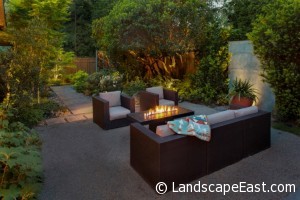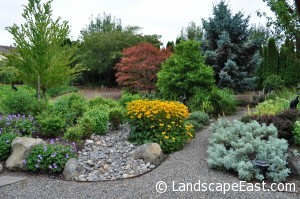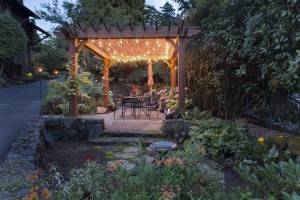Backyard Landscape Designs for Winter Entertaining
 With the right techniques, year-round outdoor entertaining is possible, especially in temperate areas like the Pacific Northwest. Why reinforce your guests’ cabin fever? Invite them to a patio party and show off your stunning winter landscape design. Below, you’ll find garden design techniques that complement Oregon winters.
With the right techniques, year-round outdoor entertaining is possible, especially in temperate areas like the Pacific Northwest. Why reinforce your guests’ cabin fever? Invite them to a patio party and show off your stunning winter landscape design. Below, you’ll find garden design techniques that complement Oregon winters.
Landscape Features to Consider
Covered patio. To create an entertainment area that’s protected from the rain, a landscape designer service would recommend adding a patio cover to your deck. Awnings may also work, but they are more likely to be damaged in storms. Once you have a covered area, add a patio heater to draw even more guests outdoors.
 Rain gardens. Although they are definitely cold and wet, Pacific Northwest winters are also gorgeous, especially if you know where to look. Adding a rain garden to your property will attract wintertime wildlife to your garden, providing you with an opportunity to see beauty even in the darkest, coldest time of the year. Furthermore, rain gardens are an environmentally conscious way to handle the heavy winter rainfall endemic to the Pacific Northwest.
Rain gardens. Although they are definitely cold and wet, Pacific Northwest winters are also gorgeous, especially if you know where to look. Adding a rain garden to your property will attract wintertime wildlife to your garden, providing you with an opportunity to see beauty even in the darkest, coldest time of the year. Furthermore, rain gardens are an environmentally conscious way to handle the heavy winter rainfall endemic to the Pacific Northwest.
Selecting Plants that Shine in Winter Weather
In other parts of the country, winter landscape design is all about choosing plants that will look lovely under a layer of frost or snow. In these cold climates, a landscape designer might choose to install pavers that will encourage quick snow melt, thus providing visual contrast during less intense snow storms.
In the Pacific Northwest, near-constant winter rain has more influence on landscape design. Beaverton and Portland gardeners can create a beautiful wintertime landscape by selecting plants that will attract the eye even on cloudy days. Here are a few suggestions:
Astilbes. These are perennial shrubs that produce feather-like flowers in the summer. As fall and winter come on, these flowers dry into intricate stalks, which add vertical interest to any winter landscape. Astilbes flourish in the clay soils that are common in the Portland area. Furthermore, they love waterlogged soil, so they thrive alongside ponds or rain gardens.
Red twig dogwood. This is a native perennial herbaceous shrub that features tiny white flowers in the spring. However, this water-lover really shines in the winter, when no other plants can compete with its striking red bark. Consider planting a row of red twig dogwoods near your deck or patio, where visitors will be able to enjoy its rosy bark.
 Ferns. Ferns often stay green all winter long in the Pacific Northwest. For instance, sword ferns’ arching fronds can provide a beautiful green feast for the eyes throughout the coldest months. Licorice fern is another cheerful choice for winter landscape design; Beaverton and Tigard property owners will delight in the fact that the licorice fern breaks its dormancy in the early winter, sprouting out fresh new growth just after the New Year. Planting a few ferns along your front walk will draw visitors to your door.
Ferns. Ferns often stay green all winter long in the Pacific Northwest. For instance, sword ferns’ arching fronds can provide a beautiful green feast for the eyes throughout the coldest months. Licorice fern is another cheerful choice for winter landscape design; Beaverton and Tigard property owners will delight in the fact that the licorice fern breaks its dormancy in the early winter, sprouting out fresh new growth just after the New Year. Planting a few ferns along your front walk will draw visitors to your door.
Ornamental grasses. Ornamental grasses are like the exclamation points of the winter garden – their fuzzy seed heads bob and sway in winter storms. Grasses add texture and height to an otherwise bland design. Landscape experts cherish all types of grasses for their unusual striations and shapes.
Bamboo. Bamboo is actually a grass that loses its leaves in the spring. In other words, bamboo will bring lush greenery to your garden throughout the winter. However, landscape designer service experts recommend planting bamboo cautiously, as this is one plant that can spread very quickly. If you want to plant traditional bamboo canes directly into the earth, you’ll need to install three-foot-deep barriers to prevent underground roots called rhizomes from spreading. (This is not true for clumping bamboo species, which are less aggressive.) Alternatively, you can plant bamboo in containers. This is a great approach to adding privacy to your winter landscape – designer ceramic pots with good drainage can be massed to create a “wall” of bamboo.
 Trees. Trees often act as the “bones” of a garden, especially in winter when their bare branches draw striking silhouettes against the purple solstice sky. Look for trees that grow in unusual branching patterns; for instance, corkscrew willows grow in spiral patterns. Of course, conifers are wonderful winter species, since they stay green all winter long.
Trees. Trees often act as the “bones” of a garden, especially in winter when their bare branches draw striking silhouettes against the purple solstice sky. Look for trees that grow in unusual branching patterns; for instance, corkscrew willows grow in spiral patterns. Of course, conifers are wonderful winter species, since they stay green all winter long.
As you browse your local nursery for plants that will be attractive in the winter, here are a few general characteristics to look for: unusual bark patterns, bright berries that will attract birds, evergreen foliage, interesting branching patterns and unusual textures.
Finally, as you work with a design/landscape service, outline high-traffic zones where you and your guests will want to tromp. Place pavers or stones in these areas so as to reduce the amount of mud that’s tracked into your home.
[ photo by: vauvau, on Flickr, via CC License ]
